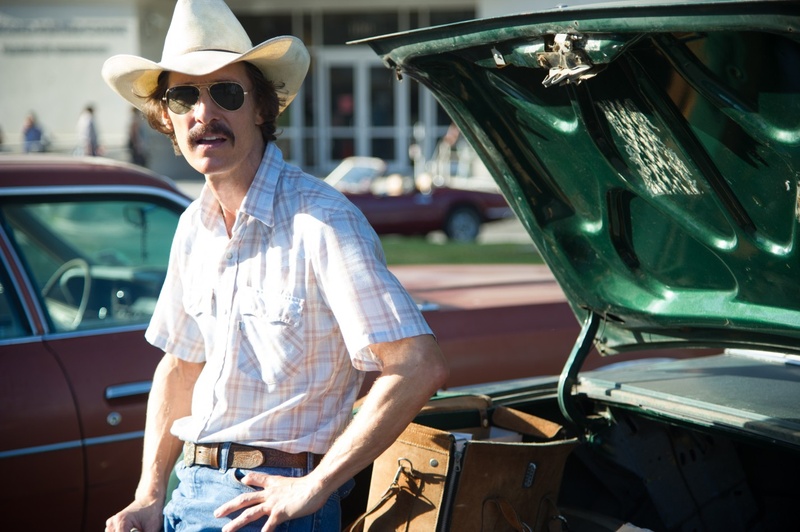The opening scene of “Dallas Buyers Club” is maybe the film’s best: it finds cowboy Ron Woodroof (Matthew McConaughey) having sex with a woman in a stall at a rodeo, staring through the slats as a bull furiously bucks its helpless rider. As Woodroof climaxes, the bull hurls its rider to the ground, where he lies inert; post-coital, Woodroof looks a man defeated, not fulfilled. The wordless scene is complexly metaphorical, perfectly acted, and immersive.
It’s such scenes that throw into relief the disappointing aspects of “Buyers Club,” though. Director Jean-Marc Vallée shows himself capable of remarkable filmmaking, guided by subtle and striking writing from Craig Borten and Melisa Wallack, so it’s frustrating when that inspired storytelling is occasionally replaced by bland exposition. “Dallas Buyers Club” is a wonderfully complete historical drama and a great film, but it struggles with some lazy stylistic choices and dull scenes.
The film presents a detailed look at Woodroof’s battle with HIV and AIDS, situating his true story deftly within gay culture and the AIDS epidemic of the 1980s. Woodroof, a straight and homophobic Texas electrician, was diagnosed around 1986 and not approved for trials of a Big Pharma drug called AZT. He was inspired by similar organizations nationwide to form the Dallas Buyers Club, where AIDS sufferers could purchase illegally smuggled and non-FDA-approved natural remedies, resulting in a clash with the FDA. Borten and Wallack’s script—originally written by Borten in 1992 after an interview with a dying Woodroof and bounced around Hollywood for 20 years—balances an admirable breadth of documentary details, from the discrimination against Woodroof as a straight AIDS sufferer to his smuggling schemes, legal battle with the FDA, and research into AZT’s potentially harmful effects.
But the film’s best story is Borten and Wallack’s own creation: a friendship between Woodroof and a transgender woman named Rayon (Jared Leto), which demonstrates Woodroof’s real-life transformation from homophobe to sympathetic advocate. The two develop a wonderfully multifaceted relationship. They’re savvy business partners who build a clientele and manage the Club’s booming finances; squabbling at the supermarket over whether to buy potato chips, they’re more like a married couple.
They become close friends whose humorous indications of mutual acceptance are one of the film’s delights—Rayon secretly adds a portrait of Marc Bolan to Ron’s masturbation fantasy wall, to the other’s eventual surprise, and Woodroof, noticing Rayon gazing enviously at a waitress’s breasts, jokes, “You’re starting to look normal.” This multidimensionality transcends typical unlikely-friendship narratives, and their bond is the film’s heart and spark.
McConaughey and Leto give impressive performances as the duo. McConaughey’s has peaks and valleys—he sticks to his laconic Texas drawl for many scenes, but he wows in desperate moments. When Woodroof hears his diagnosis, his expression dances almost imperceptibly between terrified and fiercely combative. McConaughey also masters the conflicting tones of Borten and Wallack’s best writing, like when he tells his doctor Eve Saks (Jennifer Garner), “Screw the FDA; I’m gon’ be DOA” as his eyes brim with tears.
Leto, conversely, is blessed with a role that demands a complete transformation of speaking style and manner, and he vanishes into Rayon. The stars both underwent amazing body alterations, McConaughey gaunt and loping like Christian Bale in “The Fighter” and Leto—who is no stranger to body remodeling, having gained and lost 60 pounds to play John Lennon’s killer in “Chapter 27”—trimmer by another 30 and decked in gaudy mascara. His achievement is the emphases, pursed lips, and flicks of the wrist that create a seamless character.
Their dynamic is captivating, as are the sequences where Vallée and cinematographer Yves Bélanger realize Borten and Wallack’s clever visual storytelling. In one of the best of these, Woodruff prays fervently for God to “show me a fuckin’ sign” as red light flickers on his face from what seem to be church altar candles—until the camera retracts to reveal the neon glow reflected off the bar at a strip club. Ron downs his drink, his desperation and wild lifestyle perfectly captured.
Read more in Arts
Friends, Romans, Prisoners, Lend Me Your Ears?













